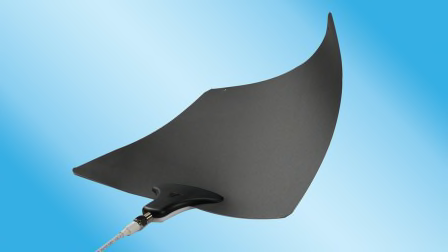TV Antenna Review: Top Picks for Getting Free Over-the-Air Channels
The right digital antenna will get you free TV stations and make it easier to cut the cord with cable
When you shop through retailer links on our site, we may earn affiliate commissions. 100% of the fees we collect are used to support our nonprofit mission. Learn more.

TV antennas might seem like a relic of a bygone era, when the number of channels you received could be counted on one hand. But as consumers try to trim their ever-escalating cable and satellite TV bills, digital TV antennas are making a comeback. In fact, about one-quarter of all broadband households now use an antenna, according to research firm Parks Associates.
Consumer Reports tests indoor TV antennas of all shapes and sizes in urban and suburban homes. We found that most locations were able to receive dozens of free over-the-air channels. (Outdoor antennas tend to perform even better, but they’re not practical for everyone.)
That’s good news for the growing number of people who are dumping traditional cable packages but keeping streaming services such as Amazon Prime and Netflix. An antenna can supply their live TV, including local news and other broadcasts—here’s our deep dive on the benefits of a TV antenna.
Become a member of Consumer Reports to get access to our TV Screen Optimizer, which will help you get the perfect picture on your TV in just minutes. Join today to get started.
Tips for TV Antenna Shoppers
The antennas we tested ranged in price from $10 to more than $100—and we found little correlation between price and performance. The antenna that pulled in the most stations for most of our testers cost $35, and several pricier models were in the lower half of our rankings.
We included some amplified TV antennas in our review. These models can boost signal strength to help pull in stations that might otherwise be on the fringe. But our tests showed that amplified antennas weren’t always more effective than nonamplified models—they can also amplify noise and distortion, and overload reception from closer stations.
The number of channels you receive will depend on your location and environment, as well as the placement of the antenna in your home. You may need to try several models before finding the best antenna for your needs. That’s why we strongly recommend purchasing from a retailer with a no-hassle return policy. Also, it’s a good idea to regularly rescan for channels because you might have missed some the last time you scanned. And use our tips on where to place your antenna to get the best reception.
How CR Tests TV Antennas
Consumer Reports had 10 testers evaluate each of the indoor TV antennas at their homes, which were scattered around the New York tristate area. Most locations were within a 40-mile radius of the Empire State Building in Manhattan, but one was 64 miles away.
Every tester used the antennas on clear days in two spots: on or facing a window, and inside a room near the TV. Signal strength generally is stronger near a window, and that’s the result we used when calculating our rankings. We also tested performance when the antenna was placed near the TV, because people don’t always have an easily accessible window.
The antennas we tested pulled in both VHF (channels 2 to 13) and UHF (14 to 51) signals. In addition, we included some amplified TV antennas in our review. For these models, we turned on the amplifier, and if there were variable settings, we used the maximum setting.
We ranked the antennas based on the number of primary RF (radio frequency) broadcast stations received across our 10 test locations. To earn a mark for reception, a station had to have a stable, viewable TV picture. In our four-year history of testing these antennas, we detected a total of 34 UHF and 11 VHF stations across all our test sites, but each location received just a subset of these stations. (In the most recent test update, our testers collectively received 10 UHF and four VHF TV stations.)
Regardless of which antenna was being used, one of our test locations wasn’t able to pull in any stations, another was able to pull in a maximum of three, and yet another was able to pull in 15 stations.
But that RF channel count understates the amount of content an antenna can give you. The tester who picked up 20 stations was able to tune to 73 subchannels.
“Unlike the old days, when tuning to a station yielded only one channel, many stations now offer multiple subchannels that provide a greater variety of programming,” Ciacci says. Such subchannels often include a mix of vintage TV shows, nature programs, weather, and foreign-language programming.
What CR’s Antenna Tests Found
Our test results should be useful for pointing you in the right direction to models you might consider, but there are a number of variables that can affect antenna performance in your home.
We tested antennas near a window and away from a window, near the TV. In the tests near a window, the three indoor TV antennas that stood out for performance were the Winegard FlatWave FL5500A, the Winegard FlatWave Amped Pro TH-3000, and the ClearStream Eclipse Amplified TV Antenna.
But there were a number of other models that also did well. And a few were significantly cheaper, at $20 or less, including the 1byone (Updated 2020) Ultra-Thin Amplified HD Digital TV Antenna and the Mohu Leaf Metro.
In the rankings below, you’ll see two figures:
The “percentage of stations received” is a weighted average of the total number of stations that a particular antenna received at each location, divided by the number of stations we found to be available at that location through all our testing.
The “percentage of VHF/UHF stations received” breaks out the two broad categories of signals that were found at each location by any given tester, across all antennas. Any time a new UHF or VHF channel was found during a given scan, it was added to the total number available for that tester.
(Back in the early analog TV signal days, most major broadcast channels were in the lower-frequency VHF band—channels 2 through 13. Now they’re scattered across both bands, so it’s important to buy an antenna that does well across the board.)


















